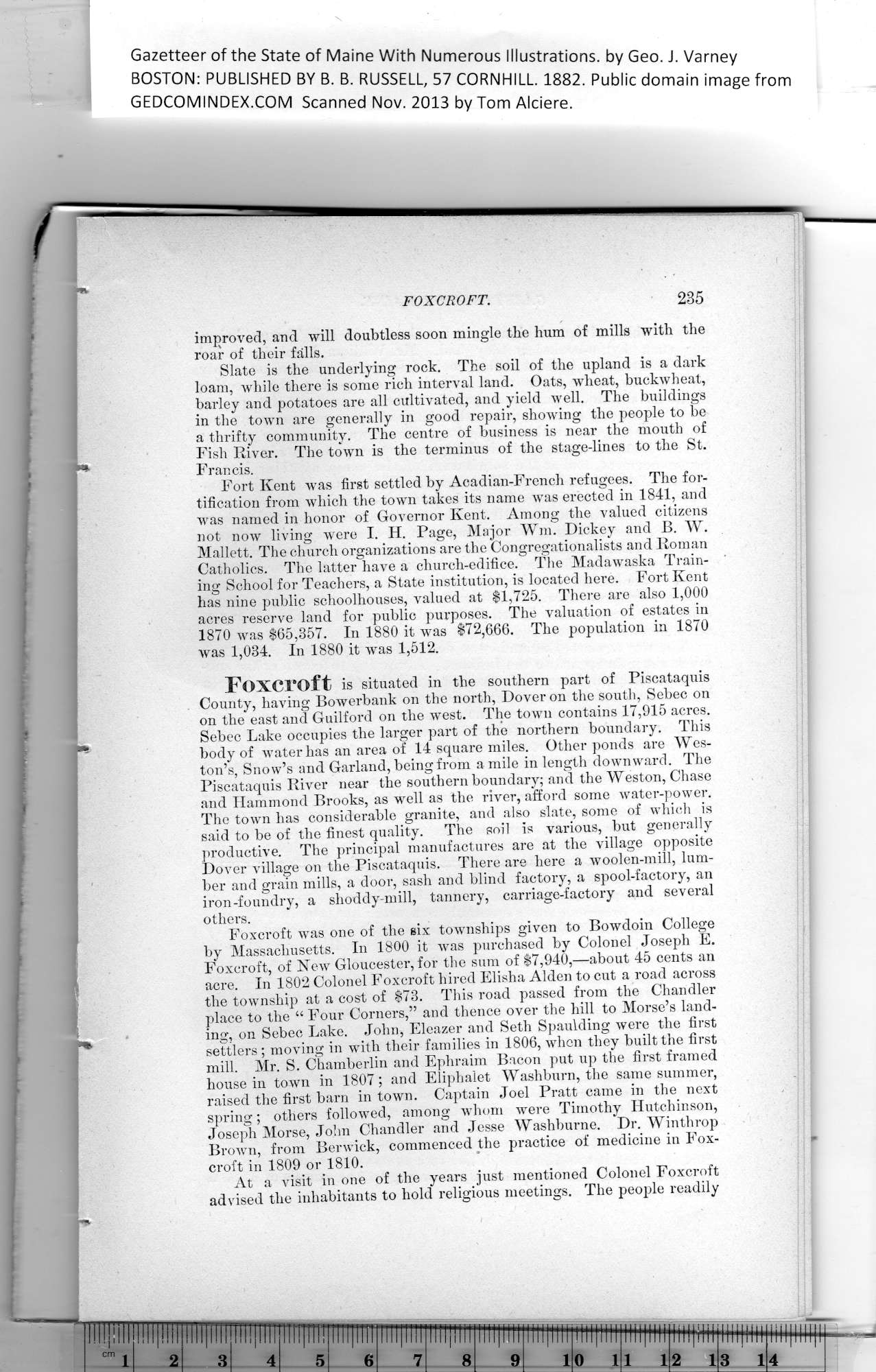|
Gazetteer of the State of Maine With Numerous Illustrations, by Geo. J. Varney
BOSTON: PUBLISHED BY B. B. RUSSELL, 57 CORNHILL. 1882. Public domain image from
!_ -
FOxCROFT. 235
improved, and will doubtless soon mingle the hum of mills with the
roar of their falls.
Slate is the underlying rock. The soil of the upland is a dark
loam, while there is some rich interval land. Oats, wheat, buckwheat,
barley and potatoes are all cultivated, and yield well. The buildings
in the town are generally in good repair, showing the people to be
a thrifty community. The centre of business is near the mouth of
Fish River. The town is the terminus of the stage-lines to the St.
Francis.
Fort Kent was first settled by Acadian-French refugees. The for-
tification from which the town takes its name was erected in 1841, and
wras named in honor of Governor Kent. Among the valued citizens
not now living were I. H. Page, Major Win. Dickey and B. W.
Mallett. The church organizations are the Congregationalists and Roman
Catholics. The latter have a church-edifice. The Madawaska Train-
ing School for Teachers, a State institution, is located here. Fort Kent
has nine public schoolhouses, valued at $1,725. There are also 1,000
acres reserve land for public purposes. The valuation of estates in
1870 was $65,357. In 1880 it was $72,666. The population in 1870
was 1,034. In 1880 it was 1,512.
Foxcroft is situated in the southern part of Piscataquis
County, having Bowerbank on the north, Dover on the south, Sebec on
on the east and Guilford on the west. The town contains 17,915 acres.
Sebec Lake occupies the larger part of the northern boundary. This
body of water has an area of 14 square miles. Other ponds are Wes-
ton’s, Snow’s and Garland, being from a mile in length downward. The
Piscataquis River near the southern boundary; and the Weston, Chase
and Hammond Brooks, as well as the river, afford some water-power.
The town has considerable granite, and also slate, some of which is
said to be of the finest quality. The soil is various, but generally
productive. The principal manufactures are at the village opposite
Dover village on the Piscataquis. There are here a woolen-mill, lum-
ber and grain mills, a door, sash and blind factory, a spool-factory, an
iron-foundry, a shoddy-mill, tannery, carriage-factory and several
others.
Foxcroft was one of the six townships given to Bowdoin College
by Massachusetts. In 1800 it was purchased by Colonel Joseph E.
Foxcroft, of New Gloucester, for the sum of $7,940,—about 45 cents an
acre. In 1802 Colonel Foxcroft hired Elisha Alden to cut a road across
the township at a cost of $73. This road passed from the Chandler
place to the “ Four Corners,” and thence over the hill to Morse’s land-
ing, on Sebec Lake. John, Eleazer and Seth Spaulding were the first
settlers; moving in with their families in 1806, when they built the first
mill. Mr. S. Chamberlin and Ephraim Bacon put up the first framed
house in town in 1807; and Eliphalet Washburn, the same summer,
raised the first barn in town. Captain Joel Pratt came in the next
spring; others followed, among •whom were Timothy Hutchinson,
Joseph Morse, John Chandler and Jesse Washburne. Dr. Winthrop
Brown, from Berwick, commenced the practice of medicine in Fox-
croft in 1809 or 1810.
At a visit in one of the years just mentioned Colonel Foxcroft
advised the inhabitants to hold religious meetings. The people readily
PREVIOUS PAGE ... NEXT PAGE
This page was written in HTML using a program written in Python 3.2
|
